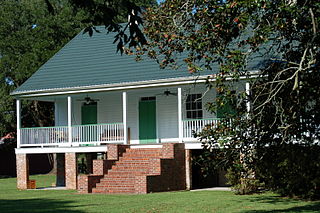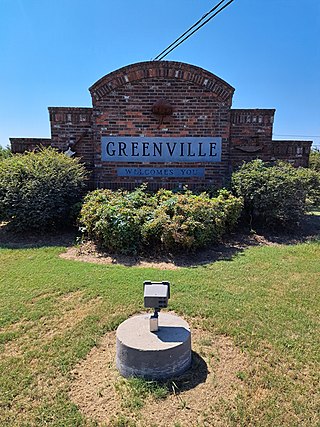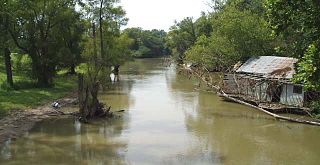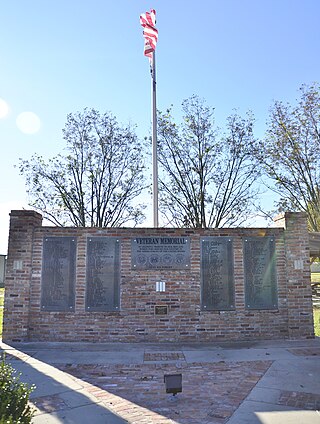
The Mississippi River is the second-longest river and chief river of the second-largest drainage system in North America, second only to the Hudson Bay drainage system. From its traditional source of Lake Itasca in northern Minnesota, it flows generally south for 2,340 miles (3,766 km) to the Mississippi River Delta in the Gulf of Mexico. With its many tributaries, the Mississippi's watershed drains all or parts of 32 U.S. states and two Canadian provinces between the Rocky and Appalachian mountains. The main stem is entirely within the United States; the total drainage basin is 1,151,000 sq mi (2,980,000 km2), of which only about one percent is in Canada. The Mississippi ranks as the thirteenth-largest river by discharge in the world. The river either borders or passes through the states of Minnesota, Wisconsin, Iowa, Illinois, Missouri, Kentucky, Tennessee, Arkansas, Mississippi, and Louisiana.

A levee, dike, dyke, embankment, floodbank, or stop bank is a structure that is usually earthen and that often runs parallel to the course of a river in its floodplain or along low-lying coastlines.

West Baton Rouge Parish is one of the sixty-four parishes in the U.S. state of Louisiana. Established in 1807, its parish seat is Port Allen. With a 2020 census population of 27,199 residents, West Baton Rouge Parish is part of the Baton Rouge metropolitan statistical area.

West Memphis is the largest city in Crittenden County, Arkansas, United States. The population was 26,245 at the 2010 census, ranking it as the state's 18th largest city, behind Bella Vista. It is part of the Memphis metropolitan area, and is located directly across the Mississippi River from Memphis, Tennessee.

Greenville is a city in and the county seat of Washington County, Mississippi, United States. The population was 34,400 at the 2010 census. It is located in the area of historic cotton plantations and culture known as the Mississippi Delta.

The Republican River is a river in the central Great Plains of North America, rising in the High Plains of eastern Colorado and flowing east 453 miles (729 km) through the U.S. states of Nebraska and Kansas.

The St. Francis River is a tributary of the Mississippi River, about 426 miles (686 km) long, in southeastern Missouri and northeastern Arkansas in the United States. The river drains a mostly rural area and forms part of the Missouri-Arkansas state line along the western side of the Missouri Bootheel.
Bird's Point is an unincorporated community in Mississippi County, Missouri, United States. It lies on an island or former island in the Mississippi River, near the confluence of the Ohio and Mississippi Rivers and is situated directly across from Cairo, Illinois. This is the point where the U.S. Route 60 bridge connects with Cairo.
The James Fork is a 50.3-mile-long (81.0 km) river in the U.S. states of Arkansas and Oklahoma, forming on the north slope of Poteau Mountain in the Ouachita National Forest in Arkansas and flowing north and west into the Poteau River near Panama, Oklahoma. Via the Poteau and Arkansas rivers, the James Fork is part of the Mississippi River watershed.
Torras is the name of a former town in the extreme northeastern corner of Pointe Coupee Parish, Louisiana, United States. The town was located along either side of the Texas & Pacific Railroad at its juncture with Lower Old River. The Mississippi River is located just to the east and the juncture of the Red and Atchafalaya Rivers just to the west.

Peyton is a ghost town in Tunica County, Mississippi, United States.
Princeton is a ghost town located in Washington County, Mississippi, United States.
Trotter Landing is a ghost town in Tunica County, Mississippi, United States.
Liverpool is a ghost town in Yazoo County, Mississippi, United States. Liverpool Landing, the settlement's port on the Yazoo River, was located 0.9 mi (1.4 km) west of Liverpool.
Refuge is an unincorporated community located in Washington County, Mississippi, United States.

Halley is an unincorporated community and census-designated place (CDP) in Desha County, Arkansas, United States. It was first listed as a CDP in the 2020 census with a population of 44.
Rockport is an unincorporated community in Copiah County, Mississippi.
Riverton is a ghost town in Bolivar County, Mississippi, United States.
Hopefield was a small community on the Mississippi River in Crittenden County, Arkansas. Its location is near or included within the current limits of the city of West Memphis, Arkansas. It was a ferry crossing point to Memphis, Tennessee, and was served by an east-west rail line built by the Memphis and Little Rock Railroad that eventually became a mainline of the Chicago, Rock Island and Pacific Railway. During the American Civil War General Stephen Hurlbut had the town burned to combat rebel activity. It was rebuilt, hit by a series of Yellow Fever epidemics, and diminished by erosion. Hopefield Chute, an Ox Bow also called Dacus Lake, and Hopefield Lake are in the area, as well as some remains. G. W. Watson moved there.












